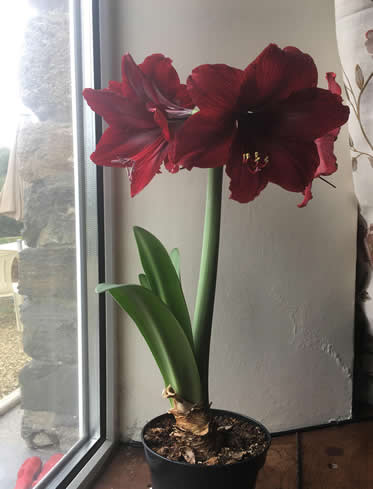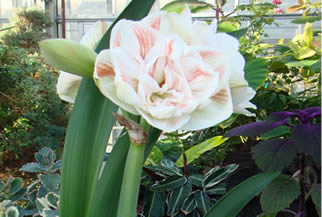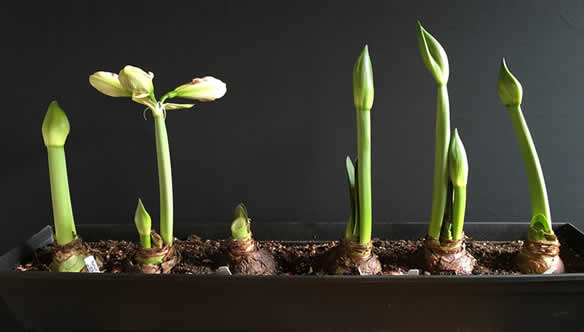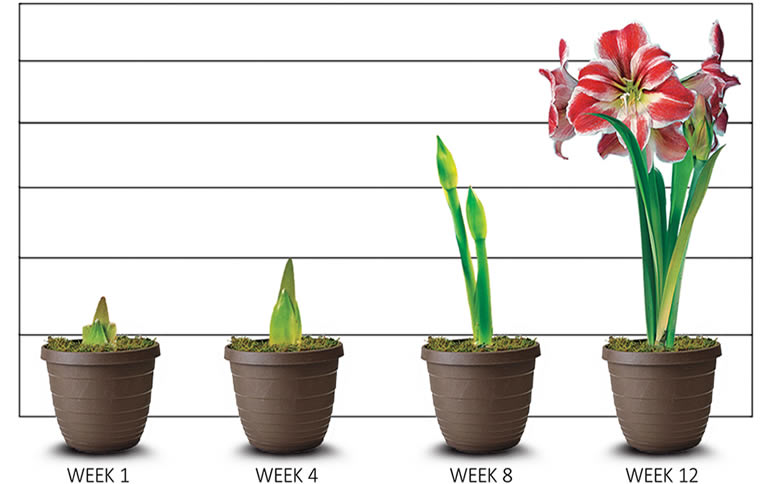Amaryllis is an easy-care succulent that is grown indoors across America. It is a very popular houseplant that follows very defined growth patterns. Here I will outline the growth stages of amaryllis and show you how you can use them to make your plant bloom at specific times during the year.
Table of Contents
The amaryllis growth cycle
Amaryllis is a succulent that is native to South Africa. Although there are only 2 species of amaryllis, many different variations of the the genus Amaryllidaceae are marketed as amaryllis plants.
If you wish to know more about the 2 specific species of amaryllis and the many different varieties of Amaryllidaceae that are sold as amaryllis read the article what kind of flower is amaryllis.
Although there are Amaryllidaceae plants that are misclassified as amaryllis there is no need to be concerned about hunting down the specific species of plant you have as all 1600 different varieties require the same care and follow a similar growth cycle.
As a succulent amaryllis requires warm conditions in order to survive and so it is no surprise that it is most often grown indoors in the USA.
As an outdoor plant amaryllis can be grown in USDA climate zones 9 through 11 and is sometimes grown in climate zone 8, though the plant will need to be protected from frost in winter and early spring in this zone.
The growth cycle of an outdoor amaryllis and an indoor amaryllis are the same.
However, outdoor amaryllis tend to bloom in spring while indoor amaryllis can be cultivated to bloom at any time because you have more control over the climatic conditions, and hence the growth stages, of an amaryllis houseplant.
The basic stages of amaryllis growth
Amaryllis is most often grown from bulb.
But it is possible to begin cultivation from seed. Although I don’t really advise you to do this as it’s not really worth the effort, unless you want to cultivate a new plant from an existing one, I will nonetheless outline the growth cycle of amaryllis from seed to first bloom.
Once the seed has been planted it will germinate in 1- 4 weeks. When the seed germinates it forms a single root that eventually forms into a bulb.

Below is the basic growth cycle of the amaryllis from seed to bloom.
The life cycle of amaryllis from seed
- 1 – 4 weeks for the seed to germinate.
- Within a few weeks sprouts will start to grow.
- Sprouts resemble blades of grass and take several years to fully grow.
- It can take 3 – 14 years for an amaryllis plant, grown from seed, to bloom.
As you can see it takes a long time to cultivate a blooming amaryllis from seed.
The root from a viable seed needs time to form into a bulb and the bulb must then be given time to mature before you can expect to see blooms.
This is why most amaryllis are sold as mature bulbs rather than in seed form. I never grow amaryllis from seed simply because I don’t have to.
Amaryllis bulbs are in ample supply though you should feel free to grow new plants from seeds you gather from spent amaryllis flower buds on your existing plants.
As the vast majority of my readers will be, like myself, growing amaryllis from bulb I will therefore only outline the growth cycle of amaryllis from the point of view of a fully matured bulb.
The growth cycle from dormancy to bloom with a mature bulb is relatively short with full blooms appearing 6 – 12 weeks after planting.
The life cycle of amaryllis grown from bulb
- Leaves will form directly from the bulb immediately after it comes out of dormancy.
- You may see leaves forming first with separate straight stalks growing afterwards or they may grow simultaneously.
- Leaves will grow from week 1 through to week 6.
- Stalks will appear at any time from week 1 through to week 6. This means you can expect blooms at any time from week 6 through week 12 week depending on when the stalks first appeared, i.e. it takes 6 weeks from the appearance of a stalk to a flowering of that stalk. As a general rule you can expect to see flowers from week 8.
- Once blooming has finished the amaryllis bulb will start to enter a stage of dormancy that lasts approximately 2 – 3 months, before it enters another growth cycle.
Amaryllis, unlike many other plants, does not require darkness during dormancy.
As long as you do not stimulate the plant to enter another growth cycle it will happily rest and gather resources sitting in the same spot.
Although you can leave your dormant amaryllis in the same spot you must be careful not to stimulate the bulb during this stage as doing so will restrict its ability to bloom and will harm the plant.
See this article for more details about that.
Normal outdoor amaryllis growth stages
As I already pointed out earlier there are only 2 species of amaryllis, with all other plants sold as amaryllis being of the genus Amaryllidaceae.
You will often see seeds and plants being sold as amaryllis that are also marked as Hippeastrum (especially in the UK).
So, for the sake of convenience I will simply refer to these plants as amaryllis (even though they aren’t!).
So, outdoor amaryllis are tropical and subtropical plants that require warmth and light to grow and thrive.
They react poorly to temperatures below 60 degrees fahrenheit and will die if subjected to frost. For that reason these succulents can only be grown successfully outdoors in USDA climate zones 9 through 11.
Having said that, amaryllis can be grown outdoors in USDA climate zone 8 but the plant most be given appropriate winter protection from the end of fall through to mid-late spring, when the risk of frost has passed.
Outdoor amaryllis growth cycle:
- October or early November the plant enters a growth stage.
- First signs of leaf/stalk growth within 1- 3 weeks.
- Expect full blooms from late winter through early spring. The plant only blooms once per year.
- Dormancy for 2 – 3 months before entering a new growth cycle.
The following information for the growth stages of an indoor amaryllis apply equally as well to an outdoor amaryllis.
However, be aware that an outdoor amaryllis will follow its natural growth cycle culminating in a spring bloom whereas an indoor amaryllis can be cultivated to bloom at different times.
Indoor amaryllis growth stages
An amaryllis bulb is planted in a pot so that its uppermost pointed part is above soil level.
When the bulb is in its growth stage it will produce leaves directly from this top part of the bulb.
The leaves grow upright and slightly bend under their own weight. Although there will be a slight bend in the leaves of an amaryllis, a drooping plant or one that has the appearance of falling over is not normal and the plant requires attention (see this).
As these leaves grow, separate straight stems form from the bulb that contain the buds for flowering.
In some amaryllis plants the leaves will form first with the stalks only appearing after the plant has healthy foliage. However, stalks can appear at the same time as the leaves.
It takes 6 weeks for leaves to fully grow and 6 weeks for stalks to produce flowers.

As flowers appear from the stalks only and not the leaves this means the timing of the blooming of the plant is dependent on when the stalks first appeared.
From the first appearance of a stalk to its flowering takes 6 weeks.
So, from planting to blooming it can take between 6 – 12 weeks for an amaryllis plant to go through its grow cycle – depending on when the stalks appeared and bloomed.
Stalks that grow at the same time as leaves will result in an amaryllis with a 6 week growth cycle. Stalks that appear after the leaves have grown fully will have a 12 week growth cycle.
And, of course, there are plants that fall in between those two extremes with stalks appearing after the leaves have formed but before they have matured.
This cycle ends when blooming has finished. At this point the bulb enters dormancy for 2 months though this may last up to 3 months.
The leaves of the plant will let you know when the bulb wants to rest.
Amaryllis leaves are a nice lush green color and when they start to turn yellow at the tips this is a sign that the plant is going into dormancy.
How long does it take an amaryllis bulb to bloom indoors?
Growing amaryllis indoors is exceptionally easy. All you have to do is ensure the temperatures are keep at a comfortable level for the plant and that it is watered regularly. But how long does it take to see your first flower?
Amaryllis grown indoors in the correct environment will bloom 6 – 12 weeks after planting.
As a general rule-of-thumb you can expect an amaryllis bulb to bloom 8 weeks after it has left the dormancy stage or after it has been first planted.
As I mentioned above, this 8-week-rule means you can stagger the planting of different amaryllis bulbs, even using different varieties, so you can have a constant amaryllis bloom in your home throughout the year.
When you stagnate the planting of amaryllis as one plant finishes blooming, and starts to enter dormancy, another plant will start to bloom.
You can learn more about the lifespan of amaryllis bloom here.
If you plan to use amaryllis blooms as cut flowers be sure to read our guide on that here so you get your vase flowers to last longer.
How to control the blooming cycle of indoor amaryllis
The great thing about amaryllis is that you can control when the plant blooms.
Because amaryllis are mostly grown in the US as a houseplant you don’t need to rely on the seasons for blooming.
Outdoor amaryllis bloom naturally in the spring (in the correct climate zones). But, because homes are kept at a constant temperature it is possible to cultivate your amaryllis to bloom in any season or month you want it to.
Amaryllis thrive in daytime temperatures of 70° – 90° fahrenheit, these temperatures fall into the range that most homes are kept at throughout the year.
In winter we tend to heat our homes to rise to these levels and in winter we cool them to fall to these levels, creating the perfect environment for growing healthy amaryllis.
This gives us a great opportunity to cultivate amaryllis so it blooms at specific times dependent upon our own wishes and not the season.
Amaryllis goes through its growth cycle fairly quickly.
As I already mentioned above, as a rule-of-thumb you can expect to see flowers 8 weeks after planting an amaryllis bulb that has left the stage of dormancy.
This means you can not only cultivate your amaryllis bulb so it blooms at a specific time of the year but you can also have non-stop amaryllis blooms simply by planting multiple bulbs cultivated to bloom at different times.
Following the simple 8-week-rule, where you can expect to see blooms 8 weeks after planting, you can stagnate the planting of different amaryllis varieties so they bloom one after the other.

How to get amaryllis to bloom for Christmas
Amaryllis is often referred to as the Christmas Flower or Christmas Plant.
This is due to the fact that many amaryllis growers have cultivated their plants to bloom for the festive season. Just like them you can take steps to easily grow amaryllis to bloom for christmas.
Because these succulents follow a very defined and definite growth cycle you can ensure your amaryllis blooms for Christmas year on year simply by regulating its growth cycle.
This starts by forcing the bulb into dormancy and then stimulating new growth at a specified time before blooming is required.
I have already outlined that the growth cycle of a mature amaryllis bulb is between 6 – 12 weeks from planting to blooming.
Because an amaryllis can bloom at any time between the 6 week to 12 week stage of its growth cycle as a rule-of-thumb I recommend aiming for flowering at the 8 week point.
However, until you know the specific bloom point of your own plant, (you may find your plant likes to bloom at 6 weeks, or 7 weeks or 8 weeks etc. up to the 12 week point) I would suggest planting 2 or more amaryllis bulbs at different times.
Plant one amaryllis bulb 12 weeks before Christmas, in September. Plant another one 8 weeks before Christmas in October. And plant a final one in November.
This way you are almost guaranteed to have a Christmas bloom.
Though just be aware that each plant may have a different blooming stage with the first one blooming after 6 weeks and the last blooming after 12 weeks.
However, you just need to do this once as you will quickly identify how your amaryllis grows.
Once you have identified the exact blooming pattern of those amaryllis bulbs you have planted you will be be better prepared to know when to force your amaryllis bulb into dormancy.
If you already have an amaryllis and you know it’s blooming cycle, i.e. the length of time from the first signs of leaf growth to a full bloom, then you can simply force the bulb into dormancy and replant it at the specified time before Christmas.
For example, if you have an amaryllis that regularly blooms 8 weeks after it shows its first signs of leaf growth you should replant it 9 – 8 weeks before Christmas.
Forcing the bulb into dormancy to control the growth cycle timings
Obviously if you want your amaryllis to bloom at a specific time then you need to force the bulb into dormancy a few months prior to your desired bloom dates.
Under normal circumstances an amaryllis bulb does not require darkness to go dormant.
However, to force dormancy you need to remove the plant from its usual place and store it in a dry cool place away from natural light sources.
You should do this about 16 weeks before you want the plant to bloom as you will need to keep it in this environment for about 8 weeks to force dormancy and then give it 8 weeks to reach full bloom.
The ideal temperature should be between 55° – 59° Fahrenheit. Ensure temperatures do not rise above 60° and also that they do not drop to freezing levels.
Dimly lit areas with low natural light will deprive the plant of resources and the leaves will start to yellow and die indicating that the bulb is going dormant.
The plant requires very little, or no, watering at this stage and you should not water it again until you are ready for new growth unless the soil has completely dried-out (which it shouldn’t if ideal temperatures are maintained).
If you have an amaryllis that is already dormant and leafless then you can simply remove the bulb from the soil.
Place it on paper and put it somewhere dark until you are ready to replant it.
Depending on the blooming-timing-cycle of your plant, (does it usually bloom 6 weeks after the first growth signs, or 7 weeks or 8 weeks etc.), you should remove the dormant potted plant to its usual bright spot and water it once you are ready for the plant to create new growth.
Consider adding some appropriate liquid fertilizer, like one of these ones, to stimulate growth.
If you have a dormant bulb then simply repot it in new nutrient-rich potting soil, like this, and water the plant as normal.
Fertilizer is not needed when using fresh potting soil.
If you are dealing with a newly purchased bulb you can aim to plant the bulb 8 weeks before you want to see blooms though they may appear at any point between the 6 week and 12 week mark.

